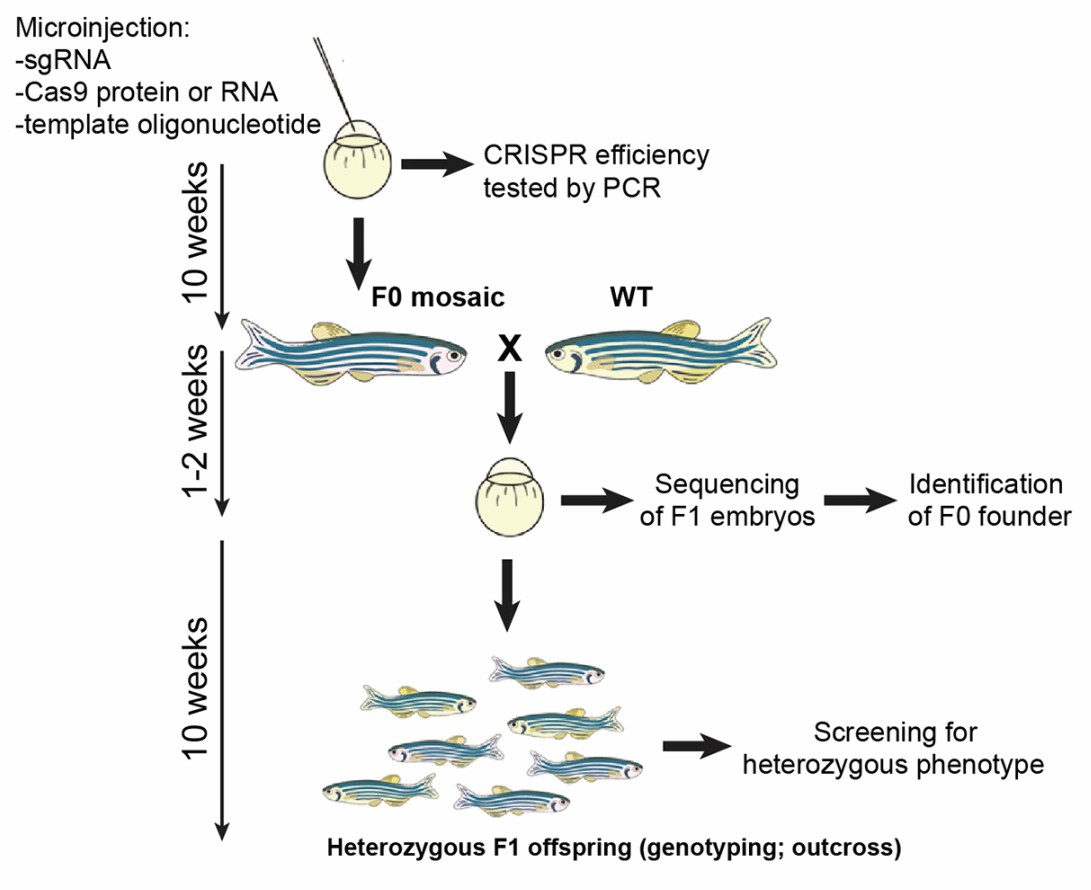Zebrafish Point Mutation Services
The zebrafish (Danio rerio) is a powerful animal model for functional genomics analysis, the study of human disease pathogenesis, as well as, for the discovery of new drugs. Zebrafish is a unique model organism at the functional intersection between a high fecundity and conserved vertebrate physiology while being amenable to multiple genome editing techniques. The zebrafish has an upper hand over invertebrate models because of its common vertebrate ancestry with humans. Due to these anatomical and genetic similarities, various zebrafish models have been developed to study the pathogenesis of human diseases, ranging from genetic disorders such as Duchenne muscular dystrophy and forms of cardiomyopathy, to acquired diseases, such as tuberculosis and melanoma.
CRISPR-Cas9 Mediated Point Mutation in Zebrafish
Strategies employing CRISPR-Cas9 are now used in all kinds of species with one of the greatest advantages being the ability to introduce specific genomic modifications. Generation of precise point mutations in zebrafish for basic research and disease modeling studies is a significant contribution of the burgeoning CRISPR-Cas9 technology, which uses a single-guide RNA (sgRNA) molecule to guide the Cas9 endonuclease to the genomic site of choice. For disease modeling, the application of CRISPR-Cas9 to generate missense point mutants of residues conserved between humans and zebrafish can be particularly useful, as these types of studies in zebrafish can be more cost-effective and scalable than in other vertebrate model animals, such as mice.
Creative Biogene, a zebrafish research company with experienced scientists and advanced technology, has established a CRISPR-Cas9 mediated methodology for introducing defined point mutations in the zebrafish genome by editing specific loci. Our method offers a versatile tool to edit the zebrafish genome at the nucleotide level and provide broad possibilities for modeling of patient-specific mutations.
Workflow of Zebrafish Point Mutation Services
- Fish maintenance and preparation
- Strategy and design
- sgRNA and Cas9 mRNA synthesis
- Microinjection in zebrafish embryos
- PCR and electrophoresis-based genotyping
 Figure 1. Generation of point mutation lines in zebrafish.
Figure 1. Generation of point mutation lines in zebrafish.
Applications
- Study a disease-causing mutation
- Explore the binding site of an enzyme
- Humanize a critical amino acid
- Introduce phosphomimetics
- Mutate isoform start sites or make any specific mutation of interest
Through incorporating these mutants into high-throughput drug screening pipelines, the zebrafish has great potential to provide rapid, cost-effective preclinical therapeutic data in a uniquely whole-organism vertebrate context that can streamline confirmatory murine studies and ultimately inform future clinical trials for patients with genetic disorders.
References
- Gonzales A P W, Yeh J R J. Cas9-based genome editing in zebrafish. Methods in enzymology. Academic Press, 2014, 546: 377-413.
- Ata H, et al. The zebrafish genome editing toolkit. Methods in cell biology. Academic Press, 2016, 135: 149-170.
- Armstrong G A B, et al. Homology directed knockin of point mutations in the zebrafish tardbp and fus genes in ALS using the CRISPR/Cas9 system.PloS one , 2016, 11(3).
- Prykhozhij S V, et al. Optimized knock-in of point mutations in zebrafish using CRISPR/Cas9. Nucleic acids research, 2018, 46(17): e102-e102.
- Tessadori F, et al. Effective CRISPR/Cas9-based nucleotide editing in zebrafish to model human genetic cardiovascular disorders. Disease models & mechanisms, 2018, 11(10).
For research use only. Not intended for any clinical use.

